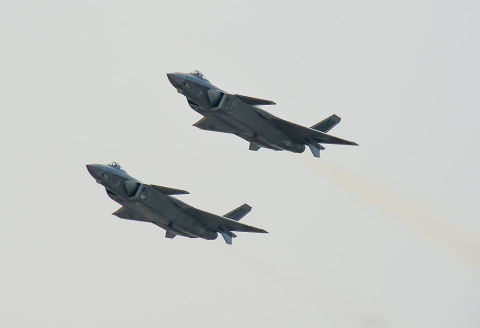http://www.popularmechanics.com/military/aviation/a25964/china-j-20-stealth-fighter/
China's first stealth fighter, the Chengdu J-20, "has the potential to provide China with a variety of previously unavailable air combat options and enhance its capability to project power." That's the conclusion of the Center for Strategic and International Studies, a Washington D.C.-based security think tank. CSIS also concludes that the fighter, first flown in 2011, could enter service as soon as 2018.
The J-20 shocked the world in 2011, when China unveiled the plane during a state visit by Secretary of Defense Robert Gates. Although China was known to be working on a large fighter, known as the J-XX, the extent to which the country had made progress on a so-called "fifth generation fighter"—which only the United States had successfully developed—shocked experts.
CSIS assesses the J-20 as a full fifth-generation fighter, which means it includes stealth technology, supersonic cruising speed, and highly integrated avionics as part of the criteria. It also believes that at 34,000 to 37,000 kilograms, the J-20 is slightly lighter than the American F-22 Raptor.
Like the F-22, the J-20 is powered by two afterburning turbofan engines. The rearward placement of the engines, according to CSIS, likely means it has more useable internal volume than the F-22. Stealthy aircraft, to remain stealthy, must hide weapons and fuel in internal bays within their fuselages. The J-20 has three such bays, two for smaller air-to-air missiles and a single large belly bay for larger air-to-air, anti-ship, and air-to-ground missiles.
CSIS notes that others see the J-20 going in one of two directions: a long range air-to-air fighter or a strike fighter capable of penetrating advanced air defenses. The aircraft is large and heavy enough to do either, but its emphasis on frontal stealth and relative weakness when scanned by radar from different angles suggests it would not do well penetrating deep into enemy territory.
The most obvious weakness at this point is the lack of a suitable engine. China originally wanted to purchase Saturn AL-41F1S engines for the J-20, the same engine that powers the Su-35 fighter, but Russia would rather sell whole aircraft (complete with higher profit margins) instead of merely engines. China has encountered problems designing high performance aircraft engines but is committed to developing a domestic engine for the J-20.
One mystery: as this article points out, if the J-20 is such an amazing plane, why is China buying Su-35 fighters? China is purchasing 24 modernized Su-35 Flanker-E multi-role fighters from Russia that fit a similar role. China may be doing so in order to harvest the technology, particularly the engines, phased-array radar, and electronic warfare capabilities.
